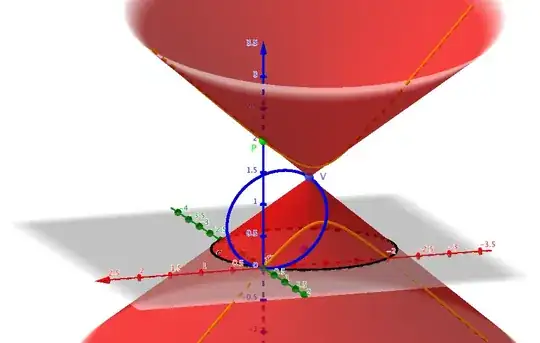That the guiding curve is a circle implies that the axis of the cone is perpendicular to the plane of the circle (that is, the $xy$-plane, which we'll call "the horizontal") and passes through the circle's center, $(-a,-b,0)$.
Also, it is "known" (and shown in this answer) that the eccentricity of a conic is given by
$$e = \frac{\sin \angle P}{\sin \angle C} \tag{1}$$
where $\angle C$ and $\angle P$ are the "cone angle" and "plane angle", the angles with the horizontal made by the cone's generator-lines and the cutting plane, respectively. Now, a rectangular hyperbola has eccentricity $\sqrt{2}$, and the plane $y=0$ makes $\angle P = 90^\circ$ with the horizontal; we find, then, that $\angle C = 45^\circ$. Consequently, the height of the cone's vertex above (or below) the $xy$-plane must be equal to the guiding circle's radius, $\sqrt{a^2+b^2}$.
The vertex of the cone is thus
$$V = (-a,-b,\pm\sqrt{a^2+b^2}) \tag{2}$$
which clearly satisfies the target equation
$$x^2 + y^2 + z^2 + 2 a x + 2 b y = 0 \tag{3}$$
for the sphere that has the guiding circle as a great circle.
Note that we have not yet introduced the "fixed point" $C := (0,0,c)$. Since we have deduced the cone's vertex without this point, we find that $c$ is not actually a free parameter in this problem. Indeed, one readily sees that, because $\overline{OV}$ and $\overline{VC}$ are generators making $45^\circ$ angles with the horizontal, $\triangle OVC$ is an isosceles right triangle with apex $V$; necessarily, the $z$-coordinate of $C$ must be twice the $z$-coordinate of $V$: that is, $c = \pm 2 \sqrt{a^2+b^2}$. Thus, the target plane
$$2 a x + 2 b y + c = 0 \qquad\to\qquad a x + b y \pm z \sqrt{a^2+b^2} = 0 \tag{4}$$
is easily seen to be satisfied by $V$. $\square$
